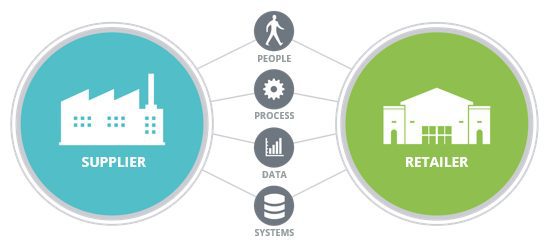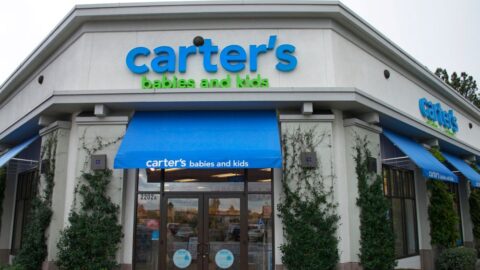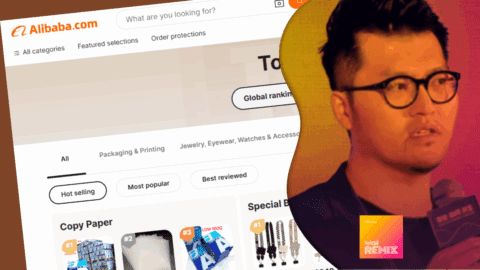Retail is all about the customer today, and it’s vital to get the first mile of the shopping journey right in order to ensure a great customer experience through the last mile. That’s where retailer-supplier collaboration comes in.
In order to get the right products to the right consumers at the right time, retailers and their vendor partners must work together cohesively.
But many supply chain partnerships remain stunted by the following challenges:
-
Siloed data: Retailers and suppliers do not have access to the same sales, promotion and customer information;
-
Differences in demand forecasting capabilities between retailers and suppliers;
-
Retailers such as Amazon moving on to suppliers’ “turf” with expanded private label programs;
-
Language, culture and communication barriers with overseas suppliers; and
-
Inconsistencies in the use of product content between retailers and suppliers.
One of the biggest issues, however, may be that retailers and suppliers view their collaborative skills quite differently. Data from SCDigest reveals that suppliers are more confident about their collaboration skills than their retail counterparts are, with 10% saying they’re “near the top” and 43% saying they’re above average, compared to 0% and 39% on the retailer side.
To help retailers and suppliers reach the next level of effective collaboration, this Retail TouchPoints report will provide an overview of today’s omnichannel-driven retail supply chain and the challenges this environment brings to the table. The report also will showcase supply chain collaboration examples from retailers such as Carter’s and Powder City as examples of how success can be achieved.
Modern Supply Chain Primes Retailers For New Supplier Relationships
As many as 44% of retailers believe that better collaboration with suppliers is a top-three issue in the areas of supply chain planning and execution, according to the State of the Retail Supply Chain 2016 report. But to build strong relationships with suppliers, retailers have had to adapt to the growth of omnichannel sales.
New sales channels and fulfillment options have completely changed the way merchants approach their supply chains. Instead of just shipping items to stores, more retailers now have to ship from their own network of multiple distribution centers, and even from the stores themselves, to get products to consumers at their convenience.
More ambitious retailers have responded to the new environment by taking the supply chain largely into their own hands, taking on an even more prominent direct-to-consumer role.
“Retailers and vendors are behaving more vertically,” said Raj Kumar, a partner in the retail and consumer practice of A.T. Kearney. “Compare a Macy’s or a L’Oréal to a lululemon that is completely vertical — they do their own design and manufacturing all while operating stores and an e-Commerce site. These retailers and vendors are trying to figure out how to act as one company. If I take all of this product and deploy it into a retailer’s distribution center or stores, I’m betting that those goods will sell in those regions that I extend that product to.”
In placing these bets, retailers also can try out new strategies — for example, holding product back at the source as long as possible until sales demand is known. The most skilled retailers save time by eliminating steps while still ensuring product doesn’t become “stranded.” While these leaders have been testing out these strategies with varying degrees of success, most retail players are still simply trying to get the hang of this new reality.
“In some ways, we’re in this in-between spot where we see a lot of the old supply chain working and a lot of the new supply chain working together,” said Jeff Ward, a partner in the transportation practice of A.T. Kearney. “So we’re headed for supply chains that are a little bit sub-scale right now, and it’s creating a demand that the U.S. supply chain wasn’t built for.”
Closing The Gap Between The Retailer And The Supplier
To navigate through this new supply chain, retailers first have to understand the constraints they may encounter, especially as they get used to selling and transporting product from, and through, various channels. Forecasting is a critical capability, for example, one that’s necessary to project how much product will be needed in each channel, and also when it will be needed. As might be expected, retailers and suppliers have different opinions as to how well demand is being estimated.
A Q4 2015 survey revealed that while retailers rated the timeliness of their own demand forecasts at a 7.34 out of scale of 10 (with 10 being the highest), suppliers only ranked retailers’ timeliness at 5.56. On a similar note, retailers rated their demand forecast accuracy at 7.38, while suppliers thought less of retailers’ precision, rating them at 5.62.
To better align forecasting, retailers should place more value on technology that considers not only past purchases and traditional market metrics but also pre-transactional signals from digital sources — such as online browsing and social media comments.
Retail Winners Emphasize Buy-Anywhere Fulfillment
The need for retailers and suppliers to align goes well beyond just forecasting, because retailers now must execute operational excellence across all channels. “Retail Winners,” — or retailers with comparable store/channel sales growth of at least 4.5% — emphasize fulfillment options designed to encourage customers to visit stores, where upselling and impulse sales might take place, according to a recent survey from RSR. But this is complicated by today’s buy-anywhere shopping environment, where product demand can literally start in one channel and end at another.
“Retailers have to think about how they plan, figure out what data is necessary and how can it be interpreted into how they buy the product, and work with suppliers to discover how the forecast can impact both upstream and downstream,” said Cyndi Fulk Lago, VP of Supply Chain Technologies at Capgemini. “I see a lot more attention going to where the demand is coming from and how it is forecasted so that when they work with suppliers, they can give them better information upfront so there’s not a lot of orders that are changed, or they don’t have to move product when it’s in one place and it needs to be in another.”
Amazon’s entrance into private label product manufacturing and sales also is keeping retailers on their toes, as the e-Commerce giant becomes both a manufacturer and a seller of its own goods. These products would immediately be set to compete against other retailers today due to Amazon’s wide array of distribution centers and lower costs, making better partnerships between merchants and suppliers even more of an imperative.
“There’s a fine line, because Amazon isn’t too far from having the ability to be a third-party supply chain supplier to everyone who’s selling on the site, but I’m not sure where that line ends,” Ward said in an interview with Retail TouchPoints. “It’s hard to find someone in retail, Big Data and the supply chain that isn’t worried about Amazon right now.”
Two Approaches To Collaboration Success: Retail Case Studies
With very different supply chain needs, both Carter’s and Powder City have built out successful collaboration efforts using technology solutions to help improve their working relationships with suppliers.
Children’s apparel retailer and manufacturer Carter’s partnered with NGC Software to create, control and manage bookings with third-party logistics providers, ensuring that logistics and transportation information is tightly integrated with other supply chain information in a single system.
“The business case was: how do we make it easier for our vendors to interact with us? How do we have a single point of contact for them?” said Ben Pivar, Vice President of Supply Chain and IT at Carter’s/Oshkosh B’gosh. “On our side, it was: how were we sure we were getting this information in a clean way?”
The inventory visibility the solution provided allows the retailer to delay decisions that otherwise would have been made earlier in the product lifecycle, further enabling the company to operate closer to consumers’ demand signals and hasten communication with suppliers.
“By having this visibility, we can not only do a better job of reducing the time cycles for us to get to market, but when things happen in the supply chain, we can make quicker decisions about what we can do about those problems,” Pivar stated. “If we have a product shipping somewhere and it arrives in a port, we are able to redirect things if the customer said they don’t want the product anymore.”
Powder City, an online retailer selling supplements and nootropics (which are designed to improve cognitive function), works predominantly with international suppliers: 60% of its product purchases come from overseas, with most sourced from China. Don Reisinger, Purchasing Manager at Powder City, credits these international relationships as a catalyst for its swift success since opening in July 2014.
“For us, it’s liberating because we have very strong relationships with these suppliers in China and in India, so it gives us the ability to reach for many new products in our pipeline,” Reisinger said. “Our existing supplier relationships can provide, or can at least give us a first step to, sourcing. Those relationships have helped us not only maintain our current supply chain, but increased the number of products we’re able to bring to market.”
Cross-Border Commerce Plays Increased Role, But Brings Added Risk
The relationship between retailers and suppliers has gotten more complex as companies seek expansion overseas. As retailers operate in more countries and deal with international suppliers, they have to navigate a different spectrum of factors beyond typical partnerships.
From a person-to-person perspective, cultural differences may be the biggest factor when it comes to building positive relationships. In the case of Powder City, the online retailer has a Mandarin-speaking associate on the team specifically to speak directly with Chinese suppliers.
“Having him be able to reach out and work directly with suppliers removes the language barrier for us to have a more open communication between us here in the States and the supplier in China,” Reisinger said. “Lead times can be longer and logistics costs are much higher to bring items in from China. It really puts an emphasis on vetting that supplier and maintaining open lines of communication about the product quality and the trends that they’re seeing. When you put that much time and money into bringing a product in, if that product somehow fails testing and is unable to be sold, it’s much more complex trying to push things back through customs then it would be with a domestic supplier.”
The cross-border complexities don’t end at logistics costs and transportation. With the recent Brexit in play, concerns about pricing and exchange rates now have become an even bigger issue for retailers (in the UK and elsewhere) partnering with European suppliers. With continued growth amidst economic uncertainty, it’s no wonder that retailers list U.S. and foreign supplier/vendor concerns as the sixth highest risk in 2016, according to the BDO Retail Riskfactor Report.
“Any time you’re dealing with an overseas partner there’s always going to be a risk,” said Natalie Kotlyar, a partner in BDO USA’s Consumer Business practice. “International operations are top of mind of 73% of retailers. We also see business interruption risks like we saw in 2015 with the strikes held at shipping terminals across the West Coast, where goods were shipped in slower.”
Why Content Matters
Although communication and visibility remain important, suppliers and vendors should not ignore a vital customer-facing factor: content. Product information for labeling must remain the same as it does in design in order to encourage purchase. Yet retailers aren’t showcasing all this information. A survey from Consumer Goods Technology and Gladson indicated that 57% of manufacturers provide some form of value added content on their site, such as recipes and product reviews, but only 40% of the retailer’s site shows the same content — even though they’re both in the business of selling products to consumers.
“All the areas of the supply chain that are engaged with supporting that shoppers’ journey to purchase — whether through category management, store operations or e-Commerce — need to be operating off of a consistent set of product information,” said Susan Sentell, CEO and President of product content database Gladson. “The shopper spends time researching that product, and at the point of purchase you don’t want to disappoint that shopper because that product isn’t the one that is available on the shelf or in the fulfillment center.”
As suppliers and manufacturers provide up-to-date product information to the retailer, merchants can promote a product more accurately and make better decisions related both to e-Commerce and within the store, from on-shelf availability to in-store merchandising.
Conclusion: Ensuring Collaboration
With continued competition lasting from the first mile to the last mile, retailers have their hands full in understanding the supply chain. But retailers can take the initiative to get on the same page with their supplier counterparts and provide consumers with exceptional experiences.
In building partnerships that can thrive, retailers must:
-
Open up communication — both internally and with the supplier — to ensure that both sides have the same goals;
-
Share demand planning and forecasts with suppliers so that both sides can deliver on these goals;
-
Improve understanding of technologies that demonstrate the highest value within the supply chain, whether through real-time inventory visibility, predictive demand analytics using customer data, or parcel shipping management systems to identify shipping costs;
-
Emphasize fulfillment options designed to handle the new “buy anywhere” climate.
“The retailer and the supplier have to make their supply chain dynamic,” said Lago of Capgemini. “Moving from a retailer-dominated supply chain to a world of being customer-centric is a big leap. The consumer is going to have more demands at the end of the day, so retailers have to have more agility, be more flexible and use the right intelligence from an analytical perspective to support that.”













